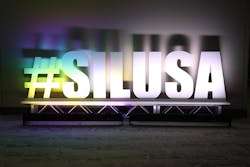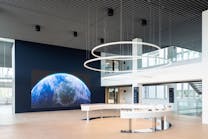Challenges and opportunities are two sides of the same coin for the SSL industry (MAGAZINE)
Though plenty of specific presentations at Strategies in Light were tailored to covering the impact of business models on the transformation of the lighting industry, it was clear to this first-time attendee that every session had something valuable to share regarding the challenges and opportunities facing the LED and solid-state lighting (SSL) supply chain. Whether representative of the research, product development and management, lighting design/specification, consultancy, or executive roles in the LED and lighting community, there were no pulled punches when it came to examining long-held expectations — nor was there any shortage of bright spots that could be found on the flip side.
Potential market pickup
Economic matters, of course, drove plenty of conversation. As Strategies in Light founder and co-chair Bob Steele presented on behalf of market-research firm Strategies Unlimited, the overall packaged LED market was down by about 4% from the previous year. Oversupply in packaged LEDs during late 2018, price erosion mid-way through 2019, and the US–China trade war made a dent in the numbers analyzed for 2019. However, Steele noted that the anticipated resolution of the trade war is cause for manufacturers to expect a pickup in demand this year and market recovery will resume, as Maury Wright details in a feature covering the keynotes.
LumEfficient CEO and EdisonReport founder Randy Reid picked up the thread of global impacts on the LED and SSL supply
chain, citing the current global health crisis as a newer challenge threatening the stability of business operations. “You’ll see some companies reporting, ‘We missed our quarterly numbers because of coronavirus,’” he said, but that “it might be a convenient excuse” given the year-plus stream of disruptions in executive management and merger and acquisition (M&A) activity amongst many of the big players in lighting — citing Signify, GE Current, Acuity Brands, Eaton’s former Cooper Lighting Solutions division, and of course, Osram. Reid countered that although 2019 was peppered with what could be construed as a plethora of negative headlines, the closing of troubled companies, the addition of jobs and renewed recruiting efforts, and the high margins attainable in niche markets are all signs that there is reason for optimism in 2020 and moving ahead.
From aesthetics to application
During the Wednesday Plenary session, lighting design consultant Thomas Paterson of Lux Populi explored the potential of the lighting design and integration community to rethink illumination, avoiding performance-metric tunnel vision and considering the purpose of the environment in which lighting is to be installed. Paterson emphasized purpose first — how the space is to be used and what the occupants should experience within it — then work out how best to deliver the experience through the form and function of integrated lighting.
Thursday keynoter James Benya of Benya Burnett concurred that design strategy must also utilize creative thinking. “LED technology has given us the ability to be artists like we’ve never been before,” he stated.
But how do you place a value on applying light in an aesthetically pleasing way to achieve the “experience” factor? The answer, I’m afraid, is that you can’t quantify it quite like you would decreased energy and maintenance costs. Benya observed that LEDs have met demands for energy efficiency, and that color and lifetime advances have been achieved since their emergence in general illumination, leaving little room for increasing that component’s performance. In fact, keynoter Bob Karlicek of the Lighting Enabled Systems & Applications (LESA) Center at Rensselaer Polytechnic Institute said in his presentation that “efficacy has hit the limit at 170 to 200 lm/W,” calling an end to the return on investment (ROI) from luminous efficacy.
From a lighting design perspective, Benya explained that his “Vision 2040” for the future of the industry relies on embracing
advanced SSL product development and lighting design techniques that fully leverage the digital and integration capabilities of LEDs rather than continuing to mimic conventional fixtures and methods of lighting the built environment. But glare remains an obstacle to the lighting experience, and the entire supply chain must work harder to address it, he said — from the component level all the way to indoor and outdoor spaces.
Karlicek, meanwhile, described the SSL industry as “grasping at future applications” in one slide, summarizing the challenges of lighting for health and wellbeing, Li-Fi for communications, and horticultural SSL as difficulty in demonstrating ROI, especially with the aforementioned efficacy limitations and the fact that he believes radio frequency (RF) will win over light-based communications in the near term. However, he added that rather than seeing this as the end of the SSL revolution, he saw expanded opportunity in developing connected lighting into truly smart building applications.
Thus, Karlicek said LESA continues to apply its efforts toward converging technologies in order to advance toward a smart, connected future based on automation and machine learning, or artificial intelligence. “The artificial intelligence of things (AIoT) will be necessary for truly smart, connected lighting,” he claimed. Occupant sensing using advanced devices with color mapping and lidar, he stated, will provide a foundation for efficient building services. Indeed, in our March issue, Signify’s Robert Lee shared a compelling and creative vision of the future based on connected lighting technologies’ role in both utilizing and enabling the “mirror world.”
All around, Strategies in Light provided space for frank discussion of the state of the industry while presenting the potential for developing better solutions to long-term business success for the LED and lighting supply chain. In a similar vein, learn how readers reacted in our first State of the Industry survey feature, where Maury Wright analyzes what the survey responses tell us about technologies, applications, and opportunities for the LED and SSL sectors to pursue. Also, mark your calendar for Feb. 9–11, 2021 when Strategies in Light will be held in Santa Clara, CA. Follow Strategies in Light on Twitter (@StratInLight) and Facebook (StrategiesInLight) and visit https://www.strategiesinlight.com for updates on the 2021 call for abstracts.
*Editor's note: Please note that at the time Strategies in Light took place and when this article was prepared for publication, there was not yet a solid indication or further discussion of the extended impact of coronavirus on 2020 industry activity and markets. Comments that were made during Strategies in Light were based on information available at the time presentations were prepared and are reported as such here. LEDs Magazine wants to be clear that in no way have we, our event speakers, colleagues, or partners intentionally minimized or misrepresented the global health crisis.

Carrie Meadows | Editor-in-Chief, LEDs Magazine
Carrie Meadows has more than 20 years of experience in the publishing and media industry. She worked with the PennWell Technology Group for more than 17 years, having been part of the editorial staff at Solid State Technology, Microlithography World, Lightwave, Portable Design, CleanRooms, Laser Focus World, and Vision Systems Design before the group was acquired by current parent company Endeavor Business Media.
Meadows has received finalist recognition for LEDs Magazine in the FOLIO Eddie Awards, and has volunteered as a judge on several B2B editorial awards committees. She received a BA in English literature from Saint Anselm College, and earned thesis honors in the college's Geisel Library. Without the patience to sit down and write a book of her own, she has gladly undertaken the role of editor for the writings of friends and family.
Meadows enjoys living in the beautiful but sometimes unpredictable four seasons of the New England region, volunteering with an animal shelter, reading (of course), and walking with friends and extended "dog family" in her spare time.







